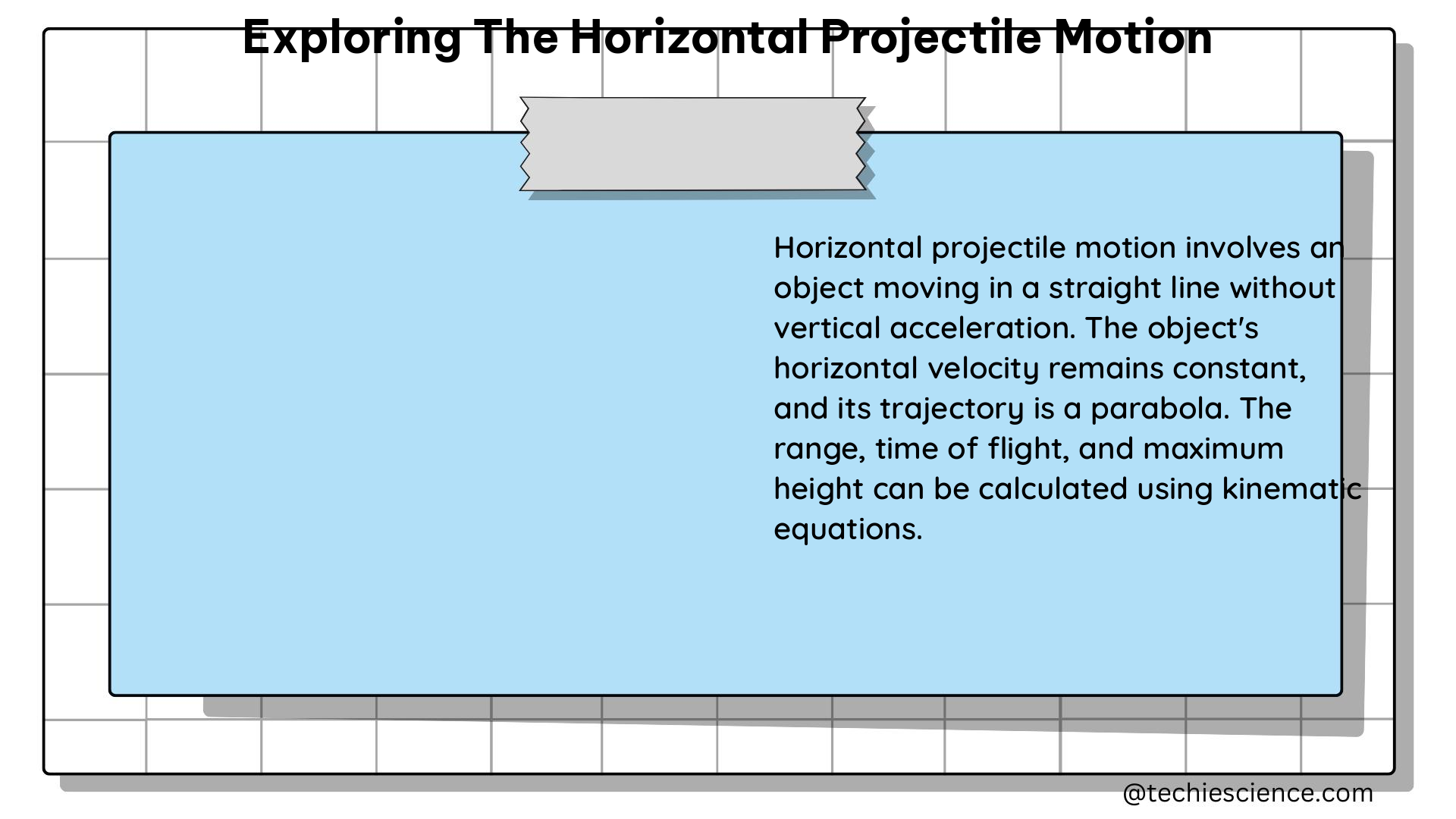Horizontal projectile motion is a fundamental concept in physics that describes the motion of an object launched horizontally and subjected only to the force of gravity. This type of motion can be described using vectors and kinematic equations, which allow us to predict the trajectory of the projectile and calculate its position, velocity, and acceleration at any given time.
Understanding the Horizontal and Vertical Components of Motion
One important aspect of horizontal projectile motion is the distinction between the horizontal and vertical components of the motion. The horizontal velocity remains constant throughout the trajectory, while the vertical velocity changes due to the acceleration of gravity. This can be described mathematically using the equations of motion for constant acceleration.
Horizontal Motion Equations
The equations of motion for horizontal motion are:
$x = v_{ix} \times t$
$v_{fx} = v_{ix}$
Where:
– $x$ is the horizontal position
– $v_{ix}$ is the initial horizontal velocity
– $t$ is the time
– $v_{fx}$ is the horizontal velocity at time $t$
Vertical Motion Equations
The equations of motion for vertical motion are:
$y = v_{iy} \times t + \frac{1}{2} \times a_y \times t^2$
$v_{fy} = v_{iy} + a_y \times t$
$v_{fy}^2 = v_{iy}^2 + 2 \times a_y \times y$
Where:
– $y$ is the vertical position
– $v_{iy}$ is the initial vertical velocity
– $a_y$ is the acceleration due to gravity
– $v_{fy}$ is the vertical velocity at time $t$
In the case of horizontal projectile motion, $v_{iy}$ is zero, so the equations for vertical motion simplify to:
$y = \frac{1}{2} \times a_y \times t^2$
$v_{fy} = a_y \times t$
$v_{fy}^2 = 2 \times a_y \times y$
These equations can be used to predict the trajectory of the projectile and calculate its position, velocity, and acceleration at any given time.
Example Calculation

Consider a projectile launched horizontally from a height of 10 meters with an initial horizontal velocity of 5 m/s. We can use the equations of motion to calculate the time of flight, horizontal range, and maximum height of the projectile.
-
Time of Flight:
$t = \sqrt{\frac{2 \times y}{a_y}} = \sqrt{\frac{2 \times 10}{-9.8}} = 1.41 \text{ seconds}$ -
Horizontal Range:
$R = v_{ix} \times t = 5 \times 1.41 = 7.05 \text{ meters}$ -
Maximum Height:
$h = \frac{v_{iy}^2}{2 \times a_y} = \frac{0^2}{2 \times (-9.8)} = 0 \text{ meters}$
These calculations can be verified using physical experiments and measurements, such as those described in the lab report linked in the references section.
Factors Affecting Horizontal Projectile Motion
Several factors can affect the horizontal projectile motion, including:
- Initial Velocity: The initial horizontal velocity of the projectile determines the range and time of flight.
- Angle of Projection: The angle at which the projectile is launched can affect the trajectory and maximum height.
- Acceleration due to Gravity: The acceleration due to gravity, which is approximately 9.8 m/s^2 on Earth, affects the vertical motion of the projectile.
- Air Resistance: In real-world scenarios, air resistance can also play a role in the projectile’s motion, causing deviations from the ideal projectile motion.
Practical Applications of Horizontal Projectile Motion
Horizontal projectile motion has numerous practical applications, including:
- Sports and Athletics: Understanding horizontal projectile motion is crucial in sports such as baseball, basketball, and golf, where the trajectory of the ball or object is crucial for scoring and performance.
- Engineering and Ballistics: Horizontal projectile motion principles are used in the design and analysis of various engineering systems, such as artillery, missiles, and other projectile-based technologies.
- Everyday Situations: Horizontal projectile motion can be observed in everyday situations, such as the motion of a ball thrown horizontally or the trajectory of a stone skipping across the surface of water.
Conclusion
Horizontal projectile motion is a fundamental concept in physics that can be described using vectors and kinematic equations. By understanding the distinction between the horizontal and vertical components of motion, and by applying the relevant equations, you can predict the trajectory of a projectile and calculate its position, velocity, and acceleration at any given time. This knowledge has numerous practical applications in various fields, from sports and athletics to engineering and ballistics.
References
- Projectile Motion – Lab – PHY 101L Module Three Lab Report. Retrieved from https://www.studocu.com/en-us/document/southern-new-hampshire-university/principles-of-physics/projectile-motion-lab/69602743
- Describing Projectiles With Numbers: (Horizontal and Vertical Velocity). Retrieved from https://www.physicsclassroom.com/class/vectors/Lesson-2/Horizontal-and-Vertical-Components-of-Velocity
- PHYSICS Projectile Motion. Retrieved from https://www.uvm.edu/~ldonfort/P21S20/3_Projectile_Motion.pdf

The lambdageeks.com Core SME Team is a group of experienced subject matter experts from diverse scientific and technical fields including Physics, Chemistry, Technology,Electronics & Electrical Engineering, Automotive, Mechanical Engineering. Our team collaborates to create high-quality, well-researched articles on a wide range of science and technology topics for the lambdageeks.com website.
All Our Senior SME are having more than 7 Years of experience in the respective fields . They are either Working Industry Professionals or assocaited With different Universities. Refer Our Authors Page to get to know About our Core SMEs.